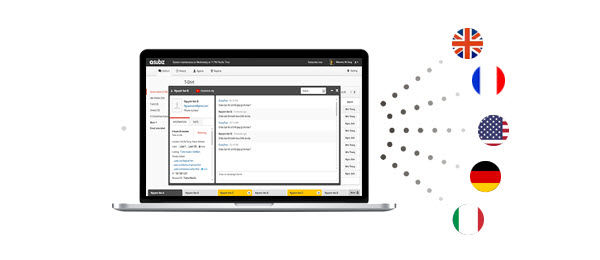It’s easy to implement as well. All you need is set up some triggers with pre-defined rules and chat message. Once a certain rule is triggered, the live chat system will automatically send out the respective pre-crafted greeting, inviting visitors to a chat conversation. This helps increase conversation rate and uplift user experience.
The thing is, proactive chat tends to be overused and may lose its power if not implemented with care. Are you sure that your proactive chat strategy does not backfire on you? Check out these 7 worst practices when using proactive chat to figure out.

1. Jump out instantly
Imagine you just make your first step into a store and the shop assistant runs to your side and bombards you with a lengthy sales pitch or a long list of, “Are you looking for this?”, “Are you looking for that?” What would you feel? Uncomfortable may be an understatement. Some would feel annoyed and may vow to never come back.
Much like a brick-and-mortar store, your online shop should never drive prospects away like that. The perfect timing for chat invitation to pop up is crucial. Don’t jump out instantly when visitors just land on your site. Or else, you may scare them away and cause them to visit other competitors. It’s best to give your visitors sometime to click around and explore your site before you go out there and offer help.
2. Produce mass invitation

Unless you are running a mass engagement campaign, it’s unwise to make your proactive chat pop up on every page and to every visitor.
It takes a lot of support resources to handle a large amount of chat conversations. Meanwhile, this strategy of targeting the masses is not effective itself. Not every visitor is a good lead. While you are busy attending to a random visitor, you may lose the chance to convert your potential customer.
Therefore, targeted chat would be more beneficial. When setting up the triggers, make sure you fire chat invitation to potential/returning/top customers and customers with pressing issues only. They are the ones who need your help the most and would have higher conversion rate. Using proactive chat at some critical buying phases or on high bounce rate pages would also yield more benefits.
For more on how to implement targeted chat, read at this blog post: Who Else Wants to Target the Right Customers with Live Chat?
3. Equate proactive chat with trigger
People sometimes forget that proactive chat can be done manually, not just automatically through triggers. No matter how convenient and profound the automatic trigger tool may seem, human monitoring is still needed for chat agents to go out there and talk to customers proactively.
Why? Since there is no perfect set of rules for triggers. You can never predict all the possible scenarios that should trigger proactive chat. New circumstances appear every day. Not to mention, those rules need to be reviewed and updated on a regular basis. Therefore, it’s imperative that, along with using triggers, chat agents should actively watch visitors’ activities on the site and reach out to them when needed. After all, a machine can never replace or surpass human intelligence.
4. Being too generic

Since you are the one initiating the talk with customers in proactive chat, make sure you sound the least invasive possible. The key to gain their trust and favour is to chat with them in their own context. People like to be addressed personally as it makes them feel more important. Thus, don’t throw out generic greetings that aim at nobody. Try to be more specific and your customers will love you.
Going personalized doesn’t have to be difficult. From the monitor screen, chat agents can learn almost everything about their online visitors (geographical location, new or returning visitors, time on site, browsing history, previous chats, etc). Those are precious data that help personalize your chat invitation in particular and live chat service in general. Why not start by greeting your visitors by their names?
5. Greeting in unfamiliar languages
It’s no use going the extra mile to set up a sophisticated proactive chat plan when your visitors don’t understand a word you say.
If your customer base is wide and scattered across the globe, it’s advisable to use local agents to send chat invitations in local languages. In case you don’t have enough resources and budget for this, a common international language like English should be used instead.
You can also pre-craft customised invitations in some major languages that your customers use. Once the system detects the visitor’s IP address and location, it can fire the right message with respective language.
6. No option to opt out

Don’t ever force your customers into a conversation they have no interest in. Some may come to your site just for some blog reading and have no intention to chat. They will click on the live chat button themselves and decide to reach out to you when needed. There is less need for proactive chat in these cases.
Thus, if customers want to opt out of the chat invitation, you should allow them to. Respect their decision and give them the choice to close or minimize the pop up window. Or else, many would feel annoyed with an intrusive agent that interrupts their browsing experience.
7. Resend a rejected invitation
Have you ever found it irritating when you just close a chat invitation on some e-store and another one pops up right after you go onto a different page? This is why shooting out mass invitation is bad.
Once your visitors reject an invitation, make sure your live chat system does not send out that message again to the same person. Or else, it would make them feel like being hunted down and they would soon leave your site.
Have you made any of these proactive chat mistakes? Do you have any experience to share? Leave a comment as we would love to hear from you.
If you are new to proactive chat, try Subiz live chat today to experience this powerful tool.




